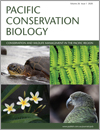
Pacific Conservation Biology
Volume 26 Number 1 2020
Australia’s high loss of biodiversity demands new approaches to the conservation and management of its natural assets. Based on identified shortcomings of current biodiversity management and existing national and international legislative mechanisms for biodiversity conservation, a five-step approach is presented to respond to Australia’s biodiversity crisis. The approach aims at a better synergy between private and public protected areas
The frequent use of bat boxes as conservation and habitat-offset tools has outpaced the research required to implement bat box programs effectively. We tested narrow-chambered boxes. These boxes were attractive for Nyctophilus geoffroyi (lesser long-eared bat) but not for Chalinalobus gouldii (Gould’s wattled bat), a species postulated to gain a competitive advantage where voluminous-type boxes are installed. N. geoffroyi showed a preference for warm boxes and the plywood box. Given that just one species commonly used the tested boxes, there is a need for further research on box designs.
PC19010Factors affecting nestling condition and timing of egg-laying in the endangered Carnaby’s cockatoo, Calyptorhynchus latirostris
This paper examines the efficacy of using the relationship between growth in the length of nestling folded left wing and body mass of Carnaby’s cockatoo Calyptorhynchus latirostris to assess nestling condition, and assesses nestling condition in 11 breeding populations throughout the species’ range. The lighter the nestling, the higher the rate of breeding failure.
This paper examines attitudes on the risks and benefits of new technologies to manage invasive species in New Zealand. Three themes emerged from our research: the risks of unintended consequences, the benefits of landscape scale technologies, and the risks and benefits of being an early adopter of new technologies.
PC18080 Abstract | PC18080 Full Text | PC18080PDF (204 KB) Open Access Article
Limited ecological information about the threatened species Arthraxon hispidus in Australia poses a challenge for biodiversity conservation. Population surveys indicated that its preferred habitat consists of dense ground-cover formations in high-moisture, low-canopy conditions, including native wetland communities. Findings provide scope to integrate management of A. hispidus into native vegetation restoration strategies.
Desert kit foxes (Vulpes macrotis arsipus) and coyotes (Canis latrans) in the Mojave Desert in California use similar food items and may engage in exploitative competition. However, kit foxes specialised on rodents and invertebrates while coyotes were more generalist consumers. Dietary specialisation by kit foxes may help reduce competition with coyotes.
Partnering sites based on shared migratory bird species can be a powerful tool for implementing conservation action for highly migratory species. We generated a list of potential partner sites for the Adelaide International Bird Sanctuary, South Australia, to assist that site in expanding their conservation impact across the East Asian–Australasian Flyway.
PC18084 Abstract | PC18084 Full Text | PC18084PDF (337 KB) Open Access Article
A self-maintaining population of redclaw crayfish is reported from a water supply reservoir in the Pilbara region in Western Australia. We suggest that reservoirs act as sources for invasion into rivers here and in other regions, and concerted management effort is required to halt the species’ spread.
Bell miners negatively influence avian diversity after colonisation but it is unknown why they colonise an area, despite documented aspects of colonisation. This is the first study to document permanent colonisation and the demise of a banded colony after a heat wave.
The presence of ranavirus, a pathogen with significant conservation importance, was investigated among highly threatened Australian amphibian populations. Ranavirus was detected from multiple sites from samples taken from endangered and critically endangered species. Further studies should be undertaken to identify any threat to native hosts by this potentially lethal pathogen.
Predation by the corallivorous gastropod Drupella cornus is well studied in the tropical and subtropical waters of the Indo-Pacific, including Ningaloo Reef and the Houtman Abrolhos Islands, Western Australia. In 1983, Drupella was not found in the Pocillopora colonies of Rottnest Island (Black and Prince 1983), and there has only been one record of D. cornus on Rottnest Island until today. We show the first feeding aggregations of D. cornus on these higher-latitude reefs of Rottnest Island, and highlight the importance of these findings.
PC18088Verified records of Kuhl’s devil ray (Mobula kuhlii) in the Solomon Islands from citizen scientists
Citizen science provides valuable information about species distributions. The Shark Search Indo-Pacific project received photographs of devil rays (Mobula spp.) from the Solomon Islands that were identified as Kuhl’s devil ray (Mobula kuhlii). These records represent new knowledge about the range and distribution of a poorly known species in an undersampled region.




